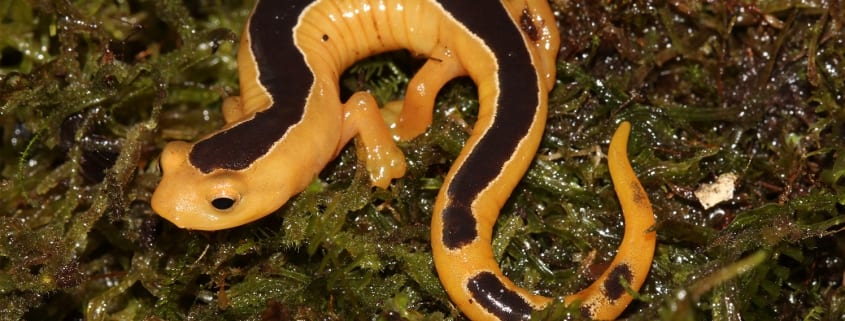“Golden Wonder” Salamander Rediscovered in Guatemala
The spectacular Jackson’s Climbing Salamander was last seen in 1977 and considered extinct. This month a forest guard at the Rainforest Trust-supported San Isidro Amphibian Reserve in Guatemala stumbled across this amazing species – the most exciting species rediscovery of the year!
The American generation born between 1883 and 1900; a hit TV series about an island; and the Jackson’s Climbing Salamander (Bolitoglossa jacksoni). Before this month, they all had one thing in common:
They were lost.
Today, Hemingway remains disillusioned and Jack and company are (spoiler alert) still dead. But the Jackson’s Climbing Salamander?
We found it.
In 1977, graduate students at UC Berkeley discovered three new salamander species in the Cuchumatanes mountain range of northwestern Guatemala. One of them was the Jackson’s Climbing Salamander. We’ve seen the two other species since — the Finca Chiblac Salamander (Bradytriton silus) and the Nimble Long-limbed Salamander (Nyctanolis pernix) — but the Jackson’s Climbing Salamander has eluded scientists for 40 years.
To put that into context: the last time a human spotted the species, “Hotel California” was the top song in America. But that was before this month.
Ramos León, a park guard at the Rainforest Trust-supported San Isidro Amphibian Reserve in Guatemala was patrolling near the reserve’s edge. During his patrol, he noticed a small, bright yellow juvenile salamander. He took a photo which confirmed the rediscovery of Jackson’s Climbing Salamander.
To amphibian experts, the Jackson’s Climbing Salamander had near-mystical status. Its bright yellow skin gave the species the nickname “golden wonder.” The few people who have seen the species opine that photographs do not give true justice to its vibrant colors.
In response to other salamander discoveries, Rainforest Trust supported the reserve’s protection in 2015 along with FUNDAECO, the Amphibian Survival Alliance, Global Wildlife Conservation, World Land Trust and the International Conservation Fund of Canada. At the time, the Jackson’s Climbing Salamander’s whereabouts remained a mystery. Yet, without prior habitat protection we would likely never have seen the species again.
“With the Cuchumatanes Range under threat – a well-known epicenter for endangered amphibians and one of the highest global conservation priorities – in 2015 we acted swiftly using our Conservation Action Fund to support the purchase and protection of critical properties,” said Dr. Paul Salaman, CEO of Rainforest Trust.
“And we are delighted to report that this important wildlife refuge has permitted the survival and ultimate rediscovery of the spectacular Jackson’s Climbing Salamander.”
And so, we know that much like the Mona Lisa in 1911 and forests in Madagascar, biodiversity can get lost. But, much like the Mona Lisa in 1914 and forests in Madagascar, biodiversity can also be found.
Support Rainforest Trust’s Work to Protect Habitat for Endangered Species Around the World




